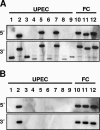Uropathogenic Escherichia coli strains generally lack functional Trg and Tap chemoreceptors found in the majority of E. coli strains strictly residing in the gut
- PMID: 16855252
- PMCID: PMC1540019
- DOI: 10.1128/JB.00449-06
Uropathogenic Escherichia coli strains generally lack functional Trg and Tap chemoreceptors found in the majority of E. coli strains strictly residing in the gut
Abstract
The prevalence and function of four chemoreceptors, Tsr, Tar, Trg, and Tap, were determined for a collection of uropathogenic, fecal-commensal, and diarrheagenic Escherichia coli strains. tar and tsr were present or functional in nearly all isolates. However, trg and tap were significantly less prevalent or functional among the uropathogenic E. coli strains (both in 6% of strains) than among fecal-commensal strains (both in > or =50% of strains) or diarrheal strains (both in > or =75% of strains) (P < 0.02).
Figures


 , P < 0.05.
, P < 0.05.
Similar articles
-
Phenol sensing by Escherichia coli chemoreceptors: a nonclassical mechanism.J Bacteriol. 2011 Dec;193(23):6597-604. doi: 10.1128/JB.05987-11. Epub 2011 Sep 30. J Bacteriol. 2011. PMID: 21965561 Free PMC article.
-
Chimeric chemoreceptors in Escherichia coli: signaling properties of Tar-Tap and Tap-Tar hybrids.J Bacteriol. 1998 Feb;180(4):914-20. doi: 10.1128/JB.180.4.914-920.1998. J Bacteriol. 1998. PMID: 9473047 Free PMC article.
-
Blue Light Is a Universal Signal for Escherichia coli Chemoreceptors.J Bacteriol. 2019 May 8;201(11):e00762-18. doi: 10.1128/JB.00762-18. Print 2019 Jun 1. J Bacteriol. 2019. PMID: 30858302 Free PMC article.
-
[Fimbriae as virulence factors of uropathogenic strains of Escherichia coli].Med Wieku Rozwoj. 2005 Oct-Dec;9(4):743-52. Med Wieku Rozwoj. 2005. PMID: 16733282 Review. Polish.
-
Escherichia coli mediated urinary tract infections: are there distinct uropathogenic E. coli (UPEC) pathotypes?FEMS Microbiol Lett. 2005 Nov 15;252(2):183-90. doi: 10.1016/j.femsle.2005.08.028. Epub 2005 Sep 6. FEMS Microbiol Lett. 2005. PMID: 16165319 Review.
Cited by
-
Chemoreceptor gene loss and acquisition via horizontal gene transfer in Escherichia coli.J Bacteriol. 2013 Aug;195(16):3596-602. doi: 10.1128/JB.00421-13. Epub 2013 Jun 7. J Bacteriol. 2013. PMID: 23749975 Free PMC article.
-
Chemoreceptors of Escherichia coli CFT073 play redundant roles in chemotaxis toward urine.PLoS One. 2013;8(1):e54133. doi: 10.1371/journal.pone.0054133. Epub 2013 Jan 30. PLoS One. 2013. PMID: 23382874 Free PMC article.
-
Chemotaxis of Escherichia coli to pyrimidines: a new role for the signal transducer tap.J Bacteriol. 2008 Feb;190(3):972-9. doi: 10.1128/JB.01590-07. Epub 2007 Dec 7. J Bacteriol. 2008. PMID: 18065551 Free PMC article.
-
Tsr Chemoreceptor Interacts With IL-8 Provoking E. coli Transmigration Across Human Lung Epithelial Cells.Sci Rep. 2016 Aug 10;6:31087. doi: 10.1038/srep31087. Sci Rep. 2016. PMID: 27506372 Free PMC article.
-
Iron limitation induces motility in uropathogenic E. coli CFT073 partially through action of LpdA.mBio. 2024 Jul 17;15(7):e0104824. doi: 10.1128/mbio.01048-24. Epub 2024 Jun 14. mBio. 2024. PMID: 38874412 Free PMC article.
References
-
- Adler, J., and M. M. Dahl. 1967. A method for measuring the motility of bacteria and for comparing random and non-random motility. J. Gen. Microbiol. 46:161-173. - PubMed
-
- Bender, D. A. 1985. Amino acid metabolism, 2nd ed. Wiley, New York, N.Y.
-
- Blattner, F. R., G. Plunkett III, C. A. Bloch, N. T. Perna, V. Burland, M. Riley, J. Collado-Vides, J. D. Glasner, C. K. Rode, G. F. Mayhew, J. Gregor, N. W. Davis, H. A. Kirkpatrick, M. A. Goeden, D. J. Rose, B. Mau, and Y. Shao. 1997. The complete genome sequence of Escherichia coli K-12. Science 277:1453-1474. - PubMed
Publication types
MeSH terms
Substances
Grants and funding
LinkOut - more resources
Full Text Sources
Medical
Miscellaneous

